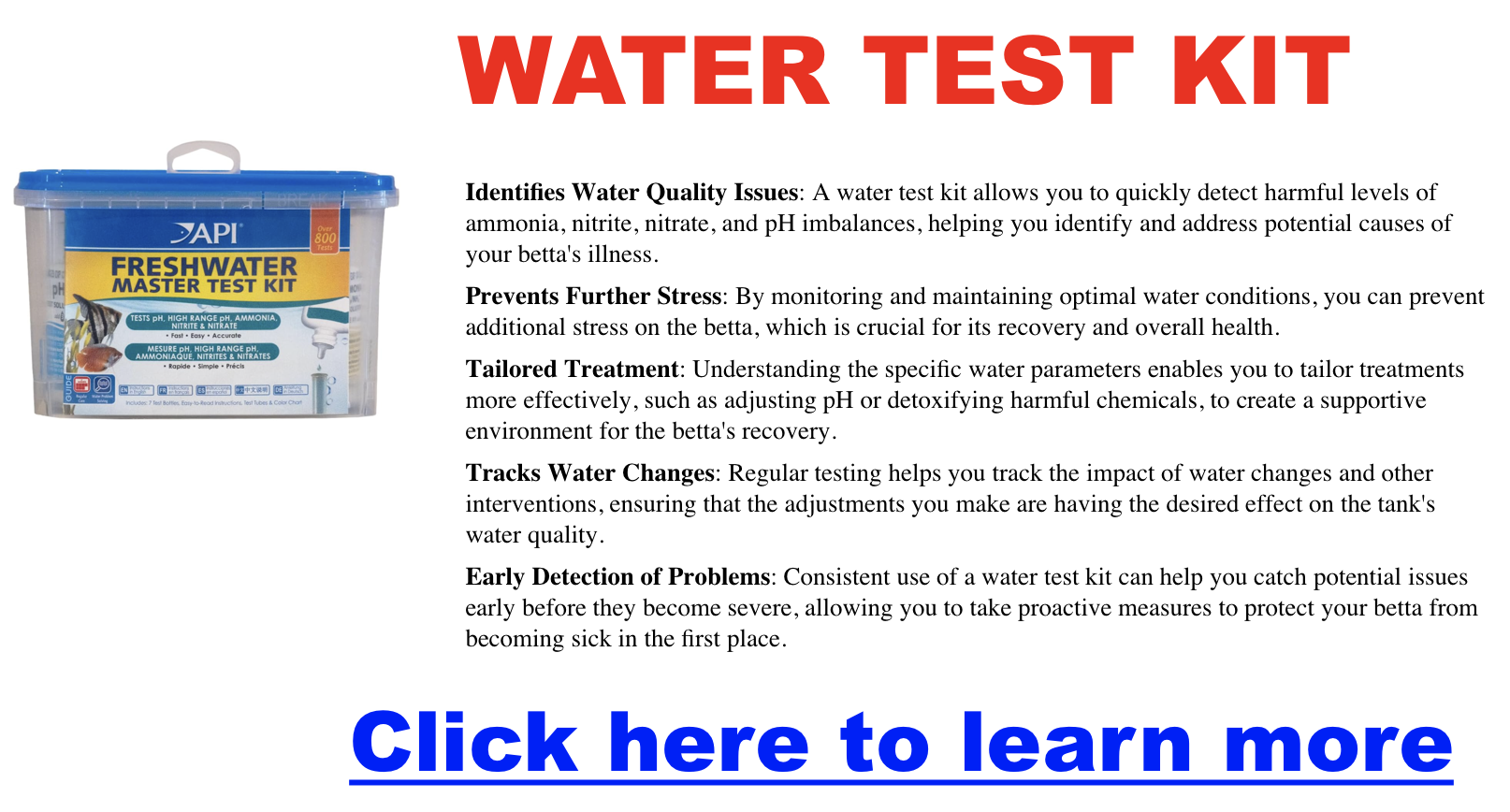Matt
What Is Betta Fish Dropsy & How To Treat It

credit: betta fish forum: pineconing of the fins
Quick Summary: Dropsy in Betta Fish
- Cause: Bacterial infection, kidney failure, poor water quality
- Symptoms: Bloating, pinecone scales, lethargy, appetite loss
- Treatment: Isolate fish, Epsom salt bath, Kanaplex or Maracyn Two
- Outlook: Often fatal if not caught early
- Prevention: Clean tank, stable water, high-quality food
What is Dropsy in Betta Fish?
Click here for our betta fish care guide ebook
Dropsy in betta fish is not a disease but a symptom of a deeper internal problem. It typically signals organ failure, a bacterial infection, or another systemic issue. The most recognizable sign of dropsy is raised scales that give the fish a pinecone-like appearance due to internal swelling and fluid retention.
Early Symptoms of Dropsy in Bettas
Catching dropsy early is critical. Here are the signs to watch for:
- Swollen belly that affects the whole body, not just the stomach area
- Pinecone-like scales when viewed from above
- Lethargy and lack of movement
- Loss of appetite, even when offered favorite foods
- Color fading or a pale appearance
- Bottom-sitting or floating sideways
- Gasping at the surface for air
Tip: Compare your betta to images of healthy fish. A side-by-side comparison often reveals changes more clearly.
What Causes Dropsy in Betta Fish?
Dropsy is most often caused by a gram-negative bacterial infection, but many contributing factors can trigger it:
- Kidney or liver failure that prevents fluid regulation
- Poor water quality, such as high ammonia or nitrite levels
- Sudden temperature changes or cold water
- Overfeeding and poor diet
- Stress from overcrowding or aggressive tank mates
- Old age, which makes bettas more susceptible to internal failures
How to Treat Dropsy in Betta Fish
Step-by-Step Treatment:
- Move your betta to a hospital tank with clean, warm water (78–80°F).
- Lower the water level to help the fish reach the surface easily.
- Add an air stone to improve oxygenation.
- Add Epsom salt (0.5 teaspoons per gallon). Make sure it’s fully dissolved.
- Administer antibiotics:
- Kanaplex (kanamycin-based) or
- Maracyn Two (minocycline-based)
- Follow the dosage instructions strictly. Don’t stop treatment early.
- Keep your main tank separate. Do not return hospital water to it afterward.
Note: If your betta is no longer eating, choose medications that are absorbed through the skin and gills.
Is Dropsy in Bettas Curable?
Dropsy is often fatal in advanced cases. If caught early, treatment may work. Many fish do not survive, but some recover with aggressive early care.
In cases where your fish is severely bloated, not responding to treatment, and suffering, humane euthanasia may be the most compassionate choice.
How to Prevent Dropsy in Betta Fish
Prevention is key:
- Keep your tank clean and cycled
- Maintain a steady tropical temperature (78°F)
- Feed high-quality food in small portions
- Test water regularly for ammonia, nitrite, and nitrate
- Quarantine new tank mates or live foods before introducing them
Recommended Medications for Dropsy
| Medication | Brand | Active Ingredient | Where to Buy |
|---|---|---|---|
| Kanaplex | Seachem | Kanamycin | Amazon link |
| Maracyn Two | Fritz Aquatics | Minocycline | Amazon link |
These antibiotics are known to help treat internal bacterial infections responsible for dropsy. Use only as directed.
Click here if your betta has stopped eating altogether or if the betta is floating near the top as it might be swim bladder. We also have a full list of diseases here.
How To Clean a Betta Fish Tank For Beginners
Cleaning your betta fish tank is crucial for maintaining your fish’s health and happiness. This step-by-step guide walks you through everything you need to know—from prepping your betta’s temporary home to safely reintroducing them to their clean tank.
Step-by-Step Betta Tank Cleaning
Click here for my favorite betta tank cleaning kit
Step 1: Prepare the Temporary Home
Fill a container with dechlorinated water that matches the tank temperature. Use a net or cup to gently transfer your betta to this temporary home.
Step 2: Remove a Portion of the Water
Scoop out 25-50% of the current tank water and pour it into a clean bucket. You’ll reuse some of this water to help your betta acclimate.
Step 3: Unplug Equipment
For safety, turn off and unplug any filters, heaters, and lights before proceeding.
Step 4: Remove Decorations and Plants
Take out any tank decor or live/artificial plants. Rinse them in some of the removed tank water or fresh dechlorinated water.
Step 5: Vacuum the Gravel
Use a gravel vacuum to clean the tank substrate. Work in sections to remove uneaten food, waste, and debris.
Step 6: Clean the Glass
Scrape off algae using an algae scraper. Wipe down the tank’s interior with a soft cloth or sponge soaked in old tank water.
Step 7: Reassemble and Refill
Return the decorations and plants to the tank. Slowly refill with dechlorinated water, ensuring the temperature matches the original water.
Step 8: Acclimate and Return Your Betta
Allow the new water to reach room temperature (72-80°F). Acclimate your betta by gradually mixing some of the new water into the temporary container. Then gently net and transfer your betta back into the tank.
Step 9: Reconnect Equipment
Plug in and restart your filter and heater. Monitor the temperature and water conditions to ensure a smooth transition.

credit reddit.com
Why a Clean Tank is Important
- Prevents Disease: Waste and uneaten food break down into harmful ammonia and nitrites.
- Promotes Well-Being: Clean water boosts coloration, behavior, and immune health.
- Reduces Algae: Consistent cleaning controls unsightly algae buildup.
Essential Supplies for Betta Tank Cleaning
- Temporary Container: Clean, fish-safe bowl or tub
- Water Conditioner: Neutralizes chlorine and chloramines
- Bucket: Used only for aquarium maintenance
- Gravel Vacuum: Removes debris from substrate
- Algae Scraper: For removing algae buildup
- Soft Cloth or Sponge: For wiping interior glass
- Paper Towels: For cleaning up drips and spills
How Often Should You Clean a Betta Fish Tank?
- Small Tanks (<5 gallons): Once per week
- Larger Tanks (5+ gallons): Every 1–2 weeks
- Unfiltered Tanks: Multiple times weekly
Extra Betta Tank Cleaning Tips
- Never Use Soap: Soap is toxic to fish—use only clean, dechlorinated water.
- Match Water Temperature: Sudden changes can shock your fish.
- Quarantine New Items: Rinse new decorations before adding them.
- Always Use Conditioner: Vital for removing harmful chemicals.
- Maintain Neutral pH: Aim for 7.0; test before reintroducing your betta.
Frequently Asked Questions
Click here for the secrets to simple, happy betta fish care…
How often should I clean my betta tank?
Small tanks need weekly cleaning; larger tanks may only need it every 1–2 weeks if filtered.
Can I use some kind of soap to clean the tank?
No. Soap can leave behind residues that are lethal to fish.
Do I need to remove my betta while cleaning?
Yes. It’s safer for your betta to stay in a temporary home during cleaning.
What’s the safest way to reintroduce my betta?
Acclimate them slowly to the new water by mixing it with their temporary water before transferring.
Is My Betta Fish Pregnant?
A common misconception exists regarding the reproductive process of betta fish. While some fish species are indeed viviparous (livebearers), bettas are oviparous (egg-layers). This distinction is crucial, as females develop eggs that are subsequently released and fertilized externally rather than carrying embryos internally until birth. In other words, a betta fish is never ‘pregnant’, but it might be full of eggs ready to lay.
Here’s the scoop on betta breeding:
- Betta Fish Eggs: Female bettas develop eggs, and their bellies may appear plump. This doesn’t mean they’re pregnant, just ready to spawn (release eggs) if a male is present. Eggs hatch in about 3 days. We have an article that talks more about the eggs and egg nests here.
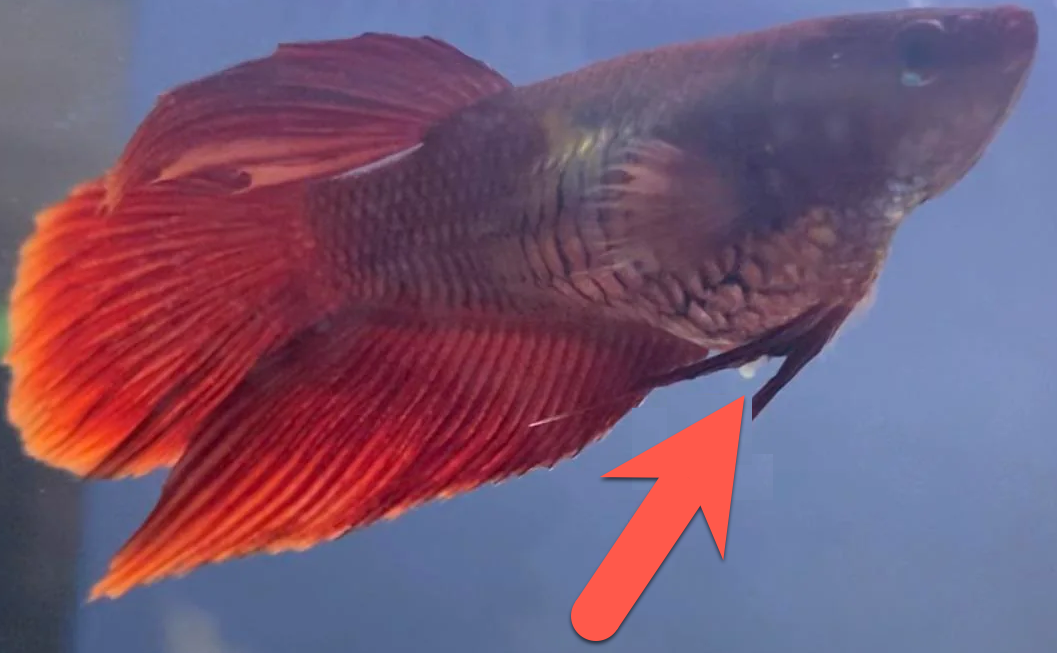
Egg spot shown here – credit: reddit user Sea-Explanation4816
- The Spawning Dance: If a male betta is in the tank, he’ll build a bubble nest and court the female. If she’s interested, she’ll release eggs, and the male will fertilize them and place them in the bubble nest.
- No Womb: Unlike livebearers (like guppies), bettas don’t carry fertilized eggs inside them. The eggs develop in the bubble nest until they hatch.
So, what if your betta looks plump and there’s no male around?
- Not All Puff is Pregnancy: Bettas can bloat due to overfeeding or constipation. Observe their behavior and droppings to rule these out. We have a guide on betta diseases and ailments which can help diagnose the issue.
- Egg Absorption: If there’s no male, the female will eventually reabsorb the eggs.
Want to learn more about betta breeding?
If you’re interested in breeding bettas, there’s a whole world to explore! Research proper tank setup, breeding techniques, and raising baby bettas (fry). I suggest getting a guidebook if your betta is laying eggs with a male around, because soon enough you might need some additional information.
Swim Bladder Disease Betta: How To Identify Symptoms, Treat It, Get a Healthy Betta
Swim bladder disease (SBD) is one of the most common health concerns betta fish owners face. When a betta starts floating on its side or struggles to stay submerged, it can be alarming. The good news is that SBD is often treatable and preventable with the right care. In this guide, you’ll learn everything you need to know about swim bladder disease: what it is, what causes it, how to treat it, and how to prevent it in the future.
🧠 What Is Swim Bladder Disease (SBD)?
Click here for our betta fish ebook health guide
Swim bladder disease isn’t technically a disease—it’s a condition that results from problems with a betta fish’s swim bladder, a gas-filled organ that controls buoyancy. When the swim bladder is impaired, the fish loses its ability to maintain balance in the water. SBD can make your betta float uncontrollably, sink to the bottom, or swim sideways.
Importantly, SBD is not contagious. It’s usually a symptom of an underlying issue such as overfeeding, poor water quality, or infection.
🚨 Symptoms of Swim Bladder Disease in Bettas
- Floating sideways or upside down
- Sinking to the bottom of the tank
- Struggling to swim upright
- Erratic or spiraling swimming behavior
- Swollen abdomen
- Loss of appetite
- Lethargy or staying in one spot
Note: A swollen belly from SBD can sometimes be mistaken for dropsy, which involves raised scales and is usually more serious.
🔍 Causes of Swim Bladder Disease
- Overfeeding & Constipation: Excess food leads to digestive pressure on the swim bladder.
- Poor Water Quality or Temperature Swings: Sudden changes or unclean water can stress your fish.
- Bacterial Infection: Can inflame or damage the swim bladder.
- Physical Injury: Rough handling or jumping out of the tank.
- Genetic Factors: Some bettas, especially fancy breeds, are more prone to swim bladder issues.
🛠️ How to Treat Swim Bladder Disease
1. Fast Your Betta (1–3 Days) Give your betta a break from food to let its digestive system rest and clear.
2. Adjust the Diet If constipation is suspected, offer a small piece of cooked, deshelled pea or high-fiber food like daphnia.
3. Improve Water Conditions Keep the tank clean and maintain a temperature between 78–82°F. Stable, pristine water helps recovery.
4. Lower the Water Level Reducing water depth to 8–10 cm helps the fish reach the surface more easily.
5. Use Medication (If Necessary) If you suspect infection, consider using antibacterial treatments suitable for aquarium use.
6. Epsom Salt Bath (Optional) 1 tablespoon per gallon of conditioned water for 10–15 minutes may reduce inflammation. Monitor your fish closely.
❌ Treatments to Avoid (Myths vs Facts)
- Aquarium Salt: Only helps with external bacterial infections, not swim bladder issues.
- Peas as a Cure-All: Only effective if constipation is the root cause.
- Overmedicating: Can stress your fish further if the wrong issue is being treated.
🛡️ How to Prevent Swim Bladder Disease
- Feed Properly: Small, consistent meals once or twice a day. Avoid overfeeding.
- Keep the Water Clean: Regular water changes and filtration are essential.
- Control the Temperature: Maintain a stable range of 78–82°F.
- Reduce Stress: Avoid overcrowded tanks and give your betta hiding spots.
- Choose Quality Food: High-quality pellets and occasional treats like bloodworms or brine shrimp.
🔬 Is It SBD or Something Else?
| Symptom | Likely SBD | Possibly Dropsy |
|---|---|---|
| Floating sideways | ✅ | ❌ |
| Swollen belly | ✅ | ✅ |
| Appetite loss | ✅ | ✅ |
| Pineconing scales | ❌ | ✅ |
| Clamped fins | ✅ | ✅ |
🏡 Bonus: Download Our Free Betta Health Tracker
Keep tabs on water parameters, behavior, and symptoms. Catch illnesses early.
📃 Frequently Asked Questions
Can a betta recover from swim bladder disease? Yes, most cases improve with proper care and fasting.
How long does it take to heal? Anywhere from a few days to over a week, depending on the cause.
Should I isolate my betta? Not always necessary, but it may reduce stress and help monitor recovery.
Can swim bladder disease be fatal? Rarely, unless caused by a severe infection or internal organ failure.
Is SBD painful for fish? It can cause discomfort but is generally not painful if treated promptly.
Betta Fish Sickness, Diseases, Illness, Problems Troubleshooting & Behavior Before Death

Sick Betta Fish Behavior
Click for our favorite betta fish care book
Recognizing the signs of disease, including changes in appetite, lethargy, fading colors, and fin clamping, is crucial for early intervention if your betta fish is sick. Not only do you want to step in immediately and make some changes, but understanding the subtle cues that may signal impending death, such as difficult breathing, erratic swimming, and prolonged inactivity, can be good indicators of the steps you need to take to save their life.
Betta fish behavior before death
Signs your betta fish might be dying. If you suspect your betta is very sick, click here to read more on behavior before death.
- Bloat: Can be caused by dropsy (see more below), overfeeding, constipation, a diet lacking in variety, or infections.
- Lethargy: A healthy betta is curious and active. If your fish rests at the bottom of the tank for extended periods or shows little interest in swimming, this is a cause for concern.
- Loss of Appetite: Bettas normally have healthy appetites. Refusal of food or spitting it out can indicate illness.
- Faded Color: Betta fish are known for their vibrant colors; fading is often a sign of deteriorating health. We have an article on bettas losing color here.
- Difficulty Breathing: Rapid or labored breathing at the surface could mean trouble getting oxygen and is a serious sign.
- Clamped Fins: Betta fins normally flow gracefully; keeping them tightly pressed to the body is a sign of stress or illness.
- Difficulty Swimming: Bettas floating on one side or sinking to the bottom of the tank.
Guide to Betta Fish Diseases and Ailments
Here’s a table that breaks down common betta illnesses, symptoms, and signs that something is wrong.
| Disease or Condition | Indicative Signs | Probable Causes |
Sick Betta Fish Care
|
|---|---|---|---|
| Columnaris | Fluffy, white patches on body or gills | Bacterial invasion in poor-quality water | Quarantine, administer antibacterial treatment, enhance tank cleanliness |
| Dropsy | Swollen body, scales sticking out | Infections leading to organ failure | Isolation, Epsom salt for swelling, seek specific antibiotics |
| Hole in Head | Depressions or holes near the head region | Nutritional deficiencies, low-quality water | Nutritional supplementation, water quality improvement |
| Ich/Ick | Tiny white specks covering fins and body | Infestation by Ichthyophthirius multifiliis parasites | Increase water temperature, salt treatment, specialized medications |
| Fin & Tail Rot | Eroding, fraying fins and tail | Fungal, parasitic, or bacterial infections, deteriorating water conditions | Clean water imperative, fungal or bacterial specific treatments |
| Popeye | Noticeable eye protrusion | Injury or bacterial infection causing fluid buildup | Improve water quality, consider antibiotics for bacterial causes |
| Swim Bladder Disease | Trouble maintaining buoyancy, floating or sinking | Improper diet, abrupt water changes | Offer dietary adjustments, ensure optimal water conditions |
| Betta Fish Tumor | Abnormal growths or swellings | Genetic predispositions, environmental factors | Maintain quality of life, consult vet for potential treatments |
| Velvet | Rusty or gold dust appearance on the body | Oodinium pillularis parasite | Reduce tank light, copper or malachite green treatment |
| Septicemia | Red lines or spots on body, lethargy | Bacterial infection in the bloodstream | Immediate antibiotic treatment, improve tank sanitation |
| Constipation | Difficulty in excretion, bloated abdomen | Overfeeding, lack of dietary fiber | Fasting followed by feeding fibrous foods like peas |
| Lethargy | Reduced activity, indifference to surroundings | Suboptimal water temperature, stress, toxins in water | Regulate water temperature, ensure cleanliness, minimize stress |
| No Appetite | Disinterest in food | Temperature fluctuations, advanced age, stress, illness | Investigate and rectify underlying issues, temperature control |
| Tail Biting | Self-inflicted injuries to the tail | Environmental stress, lack of stimulation | Enrich habitat with plants/toys, monitor for stress signs |
Columnaris
Also known as “cotton mouth,” Columnaris is a bacterial infection that presents as white or grayish spots and patches on the body and around the mouth and gills. If not addressed promptly, it can rapidly deteriorate the health of your fish.
- Tips:
- Quarantine the affected fish immediately to prevent the spread of bacteria.
- Treat the water with antibacterial medicine designed explicitly for Columnaris. Furan-2 and Kanamycin are effective options.
- Maintain high water quality through regular changes and removing uneaten food and debris.
Dropsy
Dropsy is not a disease but a symptom of underlying issues, often kidney failure. It manifests as severe bloating and raised scales, giving the body a pinecone-like appearance (fish scales sticking out). Read more on Dropsy here.
- Tips:
- While difficult to treat, early detection improves chances. Begin with isolating the affected betta.
- Offering a warm bath with Epsom salt can help reduce fluid retention.
- Consultation with a veterinarian for possible antibiotic treatments is recommended, though recovery chances remain slim.
Ich/Ick
Ichthyophthirius multifiliis, commonly known as Ich or Ick, is a parasitic infection recognizable by white, grain-like dots covering the betta fish’s body and fins. It’s highly contagious and stressful for the fish, if you suspect the parasite in your betta read on…
- Tips:
- Increase the tank’s temperature gradually to 86°F over 24 hours to speed up the parasite’s life cycle.
- Add aquarium salt at 1 teaspoon per gallon of water to help the fish produce more slime coating, offering protection against the parasite.
- Use over-the-counter Ich treatment, following the instructions carefully. Treatment should continue for at least a week to ensure all parasites, including those in the larval stage, are eradicated.
Fin & Tail Rot
Fin rot, a common affliction in betta fish, is characterized by fraying, discoloration, and receding edges on the fins. It’s often caused by poor water quality or a bacterial infection. Read more on fin rot here.
- Tips:
- Regularly clean the tank and change the water to improve conditions.
- Treat the tank with antibacterial medications, such as Maracyn or tetracycline-based products, to combat bacterial causes.
- For fungal causes, antifungal treatments like Pimafix can be effective.

Fin rot
Credit: Petco
Velvet
This parasitic disease, caused by the dinoflagellate parasite, presents as a gold or rust-colored dusting on the betta’s body. Affected fish may scratch against objects due to irritation. Click here to learn more on diagnosing and treating velvet.
- Tips:
- Quarantine the infected fish to prevent spreading to tank mates.
- Treat the tank with copper-based medications or malachite green, following dosage instructions precisely.
- Reduce lighting in the tank, as the parasite thrives in well-lit conditions.
Popeye
Popeye is an infection that causes one or both eyes to bulge outward. It can result from bacterial infections or physical injuries.
- Tips:
- Improve water quality to reduce the chance of infection.
- In cases of bacterial popeye, antibiotics can be effective.
- For injury-induced popeye, ensure the tank is safe and free of sharp decorations that could harm the fish.
Swim Bladder Disease
Swim bladder disease affects the fish’s ability to control buoyancy, resulting in floating or sinking. Overfeeding, constipation, or water quality issues might be the cause. Read all about swim bladder here.
- Tips:
- Ensure the water is at an appropriate temperature and quality to support digestion and reduce stress.
- Avoid overfeeding and provide a diet with variety to prevent future occurrences.
- Read about betta fish care and use their guidebook for treatment
Tumor
Tumors can appear as abnormal growths on the body or inside the betta. They may be benign or malignant and can vary in treatability.
- Tips:
- Little can be done at home for tumors; maintaining a stress-free environment is critical.
- Regularly monitor the tumor for changes and consult a veterinarian specialized in fish if significant changes occur.
Septicemia
Septicemia is a systemic bacterial infection that causes red streaks or spots on the body, lethargy, and loss of appetite. It is often fatal if not treated promptly.
- Tips:
- Immediate antibiotic treatment is necessary. Consult a vet for the best course of action.
- Improve tank conditions to prevent future infections. Regular water changes and monitoring for stressors are essential.
Constipation
A common issue due to overfeeding or a lack of dietary fiber, constipation is evident if your betta has a swollen belly and difficulty defecating.
- Tips:
- Fasting the fish for a few days can help clear its system.
- Feeding a small, cooked, peeled pea can aid digestion and relieve constipation.
Lethargy
If your betta is less active than usual, it could be due to cold water, poor water quality, or stress.
- Tips:
- Ensure the water temperature is stable and within the ideal range for bettas (76-81°F).
- Test the water regularly and keep the tank clean to prevent stress from poor water conditions.
No Appetite
A betta might lose its appetite for various reasons, including stress, water temperature changes, or illness.
- Tips:
- Investigate and correct any environmental stressors or water quality issues.
- Try offering different types of food to stimulate appetite, ensuring they are appropriate for bettas.
Tail Biting
Stress or boredom can lead bettas to bite their tails, causing injury and potentially leading to fin rot.
- Tips:
- To prevent boredom, provide ample enrichment in the tank, such as plants and hiding places.
- Regularly change the layout of the tank to offer new stimuli.
Actions To Take for a Dying Betta Fish
- Test Water Quality: Ammonia, nitrite, and nitrate build-up are the most common and dangerous issues in tank fish. Test immediately and address them with water changes if necessary.
- Check Temperature: Bettas need 76-82°F. A drastic change or consistently low temperature causes severe stress. Adjust with a heater if needed.
- Look for Disease Signs: Lethargy is often caused by illness. Look for additional symptoms like:
- Bloating
- White spots or patches
- Fin damage or discoloration
- Difficulty breathing at the surface
Addressing Urgent Problems
- Ammonia/Nitrite Poisoning: Perform water change (use water conditioner)
- Add ammonia neutralizer if levels remain high
- Continue daily water changes until the problem is resolved
- Temperature Issues: If too cold, use a heater
- If it is too hot, float bags of ice temporarily and find the cause (broken heater, sunlight, etc.)
- Suspected Disease: Consult a betta disease guide online for specific symptoms and treatments.
- Consider using a quarantine tank for treatment to avoid medicating the main tank unnecessarily.
Other Possible Causes and Solutions
- Appetite Loss: Try frozen or live food (daphnia, brine shrimp) for stimulation
- Fast for 24-48 hours if bloating is suspected
- If prolonged, consider internal parasites or other illnesses
- Color Changes: Look for other signs to pinpoint stress, disease, or natural aging.
- Maintain excellent water quality for long-term improvement.
- Behavioral Changes (Lethargy, Hiding, etc): Watch for tank bullies and adjust if necessary.
- Ensure enough hiding places with plants or decorations.
- Improve overall tank size and conditions.
Prevention Strategies
The cornerstone of betta fish care is prevention. Many common ailments can be avoided with the correct practices:
- Water Quality: Regularly test and maintain the parameters (ammonia, nitrite, nitrate levels, pH, and temperature) within the ideal range for betta fish.
- Nutrition: Feed your betta a varied diet, avoiding overfeeding. Mixing high-quality pellets, frozen, and live foods can provide balanced nutrition.
- Environmental Enrichment: Keep your betta stimulated with a well-decorated tank that includes hiding spots and plants. A bored betta is a stressed betta, more susceptible to illness.
- Regular Monitoring: Regularly observe your betta for signs of distress or disease. Early detection is critical to effective treatment.
Caring for a betta fish is a rewarding endeavor that comes with its set of challenges. Understanding the signs of common diseases and how to address them is crucial for any betta owner. You can enjoy your betta’s beauty and companionship for years by staying vigilant and providing a clean, enriching environment. If you believe your betta is actively unhealthy and dying, click here to learn more.
Why Won’t My Betta Fish Eat & Acting Lethargic
As a betta owner, there’s nothing more worrying than seeing your once-vibrant fish suddenly lose interest in food. It can be frustrating and even a little scary when you don’t know the cause. This guide will walk you through the most common reasons why your betta won’t eat and give you simple steps to get them back on track.
Reasons a Betta Won’t Eat
Click here for a betta fish ebook health guide
- Stress: Betta fish are sensitive to environmental changes and easily become stressed. Poor water quality, improper tank setup, bullying from tank mates, or even changes in their routine.
- Illness: Betta fish are prone to several diseases affecting their appetites, such as fin rot, swim bladder disease, or bacterial infections.
- Poor water quality: Betta fish require clean, well-maintained water to thrive. High ammonia, nitrite, or nitrate levels can cause stress and illness, leading to a loss of appetite.
- Change in diet: If you have recently switched your betta fish’s food, they may not like the new flavor or texture.
- Overfeeding: Betta fish can quickly become overfed. If you are feeding them too much, they may refuse to eat.
- Constipation: If a betta fish is constipated, they may not feel like eating. This can be caused by a diet that is too high in protein or fiber.
- Old age: As betta fish age, their metabolism slows down, and they may naturally eat less.
Betta Fish Not Eating – Troubleshooting Guide
Bettas are sensitive creatures. When dealing with water quality issues, illness, or environmental stress, it’s better to make gradual adjustments rather than significant, sudden changes. For example, if the water temperature is too low, raise it slowly by 1-2 degrees Fahrenheit daily rather than all at once. This helps minimize further stress for your fish. If you need more information on how long a betta can last without food click here.
1. Check the Basics:
- Water Quality:
- Test your tank water with a reliable aquarium test kit. Look for ammonia, nitrite, nitrate, and pH levels.
- Bettas are sensitive to fluctuations and especially to the presence of ammonia or nitrite which are toxic.
- If any levels are off, perform a partial water change (25-30%) and consider using a water conditioner to remove chlorine/chloramine and heavy metals from tap water.
- Remember: Regular small water changes are crucial for maintaining optimal conditions.
- Temperature:
- Use an accurate aquarium thermometer to ensure the water temperature is stable between 78-80°F (25-26°C).
- Rapid changes or a temperature that’s too low can suppress a betta’s appetite. A heater is recommended for most setups.
2. Food Matters:
Click Here if You’re Ready for a Thriving, Vibrant Betta
Sometimes, bettas can be picky eaters. If they’re rejecting the food you usually provide, here are some things to try:
- Live Food: Small amounts of live food, such as brine shrimp or daphnia, can awaken a betta’s hunting instincts and stimulate its appetite.
- Garlic Enticement: Soak your betta’s usual food in a bit of garlic juice (from fresh, crushed garlic). The scent can encourage them to eat.
- Variety is Key: Switch between different high-quality betta foods to see if a new formula is more appealing.
- Quality:
- Offer high-quality betta-specific foods; avoid generic fish flakes. Check expiration dates before feeding.
- Old or stale food loses nutritional value and becomes less appealing.
- Type:
- A varied diet is more stimulating. Rotate between pellets, flakes, and occasional frozen or freeze-dried treats like bloodworms or brine shrimp.
- Experiment to see what your betta prefers.
- Soaking:
- Freeze-dried foods and dry pellets should be soaked for a few minutes in tank water before feeding. This softens them and reduces the risk of bloating.
- Size:
- Bettas have tiny mouths! Crush larger food items into bite-sized pieces.
3. It Might Be Sick:
Before trying any solutions, take a few minutes to simply observe your betta. Note their overall behavior, swimming patterns, and any unusual physical changes. Are their fins clamped close to their body? Are they unusually inactive or hiding consistently? Is there any bloating, discoloration, or strange growths? These observations will guide you towards the most likely reason behind their loss of appetite.
-
Symptoms:
- Lethargy (unusual inactivity)
- Clamped fins (fins held close to the body)
- Visible spots, fuzzy growths, or discoloration
- Bloating or unusual body shape
- Loss of appetite is often a symptom of underlying illnesses in bettas.
-
Research:
- Observe your betta closely. Use the symptoms to research common betta diseases (e.g., fin rot, ich, swim bladder disease)
- Consider consulting a fish veterinarian or an experienced aquarist if you suspect illness.
4. Environmental Factors:
Click Here To Create the Perfect Betta Home
- Stress:
- New tank setups, recent changes, overstimulation from tank mates, or harsh lighting can cause bettas to feel stressed and lose their appetite.
- Provide a calm environment with places to hide, such as plants or decorations. Reduce strong water flow.
- Light:
- Aim for about 8 hours of gentle, indirect light. Bettas need a regulated day/night cycle, and too much light can be stressful.
Additional Tips:
- Fasting: If your betta appears otherwise healthy, a 1-2 day fast can help reset the appetite.
- Small Portions: Offer only what your betta can consume in 2-3 minutes, twice a day. Overfeeding contributes to poor water quality and can make your fish less interested in food.
- Patience: New environments or fussy eaters might need time. Continue consistently offering small amounts of appropriate food.
Betta Rubra
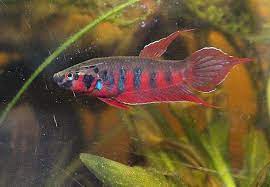
Credit: Jessie Lynn Billington
Betta rubra, also known as the Toba Betta, is a stunning wild betta species native to Lake Toba in Indonesia. Their compact size, subtle yet vibrant coloration, and engaging behaviors make them a fascinating choice for experienced aquarists seeking something unique.
Understanding the Needs of Betta Rubra
Click here for my favorite betta fish care guide for a happy & healthy life…
- Habitat Replication: Betta rubra comes from slow-moving blackwater environments. Providing soft, acidic water is critical. Consider the following:
- pH: 5.0-6.5
- Hardness: Very soft (GH 0-5, KH 0-3)
- Temperature: 77-82°F (25-28°C)
- Tank Setup: Start with a minimum of 5 gallons, but larger is better for this active fish. Densely plant your tank with live or high-quality silk plants. Include driftwood, Indian almond leaves, and subdued lighting to mimic their natural habitat. Opt for a gentle filtration system like a sponge filter.
- Peaceful Nature: Betta rubra is relatively peaceful compared to some betta species, opening up possibilities for tank setups beyond a single fish.
Feeding Your Betta Rubra
Wild Betta rubra are predominantly insectivores. Provide a varied diet for optimal health:
- Live Foods: Favorites include daphnia, bloodworms, and mosquito larvae.
- Frozen Foods: Substitute for live food when necessary.
- Pellets: Choose high-quality betta pellets formulated with minimal fillers as an occasional supplement.
Temperament and Tank Mates
- Males: They are best kept singly unless you have a large, very densely planted tank. Males can exhibit territoriality toward each other.
- Females: Can sometimes cohabitate in a spacious tank with ample hiding spots. Close supervision is a must, even with females.
- Community Tanks: Betta Rubra might suit a carefully designed community setup. Potential tank mates include small, peaceful species that thrive in similar water conditions, such as certain rasboras or tetras. Avoid large or boisterous tankmates.
Breeding Betta Rubra
Breeding Betta rubra requires dedication and experience. Here’s an overview:
- Separate Breeding Tank: Set up a dedicated breeding tank with soft, acidic water and plenty of cover.
- Conditioning the Pair: Feed the male and female high-quality live foods for several weeks before breeding.
- Courtship and Spawning: Betta rubra are bubble nesters. Observe their elaborate courtship dances and bubble nest building.
- Fry Care: Fry are tiny and require specialized foods (infusoria, microworms).
Betta Foerschi
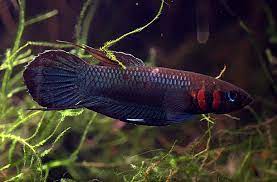
Credit: Seriously Fish
Hailing from the blackwater environments of Southeast Asia, Betta foerschi boasts striking iridescent coloration and offers a fascinating look at wild betta species. This post is meant to help create a thriving environment for them.
Understanding the Needs of Betta foerschi
- True Blackwater Fish: Like other species from these habitats, Betta foerschi require soft, acidic water. Using reverse osmosis (RO) water and a product for blackwater setups is usually essential. Aim for:
- pH: 5.0-6.5
- Hardness: Very soft to negligible (GH 0-5, KH 0-3)
- Temperature: 73-79°F (23-26°C)
- Tank Setup: Start with at least 5 gallons, though larger is always preferred. Create a densely planted environment with live or high-quality silk plants, driftwood, and Indian almond leaves. Gentle filtration, like that from a sponge filter, is crucial to avoid strong currents.
- Cover is Key: Betta foerschi naturally inhabit areas with dense surface vegetation. Include floating plants or driftwood pieces that break the surface, offering resting areas near atmospheric air access.
Feeding Your Betta foerschi
These wild bettas are carnivores. Provide a varied diet for optimal health:
- Live Foods: Their favorites include bloodworms, brine shrimp, and daphnia. These should be staples in their diet.
- Frozen Foods: Frozen versions make good substitutes if live foods are unavailable.
- Pellets: Choose high-quality betta pellets with minimal fillers and offer them sparingly as an occasional supplement.
Temperament and Tank Mates
- Males: Betta foerschi males should generally be kept alone. They will exhibit territoriality and aggression toward other males.
- Females: Can sometimes coexist peacefully in a very large, heavily planted tank. However, aggression can still occur, requiring close monitoring.
- Community Tanks: Proceed with extreme caution. Only consider this if you have extensive aquarist experience. Potential tank mates must tolerate identical water conditions and be small, peaceful, slow-moving fish that won’t intimidate the betta. Researching options thoroughly are vital.
Breeding Betta Foerschi
Breeding Betta foerschi is a project best suited for experienced betta keepers. Here’s an overview of the process:
- Separate Breeding Tank: Set up a dedicated breeding tank with the ideal water parameters.
- Conditioning the Pair: Feed high-quality live foods to encourage breeding readiness.
- Paternal Mouthbrooding: Betta foerschi are mouthbrooders. The male will hold eggs and fry in his mouth for incubation.
- Fry Care: Fry are incredibly tiny and sensitive, requiring live cultures of microscopic foods.
Additional Notes
- Availability: Betta foerschi are rarer in the aquarium trade, so you may need to find a breeder specializing in wild bettas.
- Sensitivity: Be attentive to water parameters. Betta foerschi can be less forgiving of fluctuations than some selectively bred bettas.
- Observation is Key: Monitor behavior carefully to ensure your Betta foerschi is thriving and adjust care as needed.
10 Reasons You Need a Betta Fish Guide Book for Success
The allure of betta fish, dazzling colors, and mesmerizing fins is undeniable. Beyond their beauty, many aquarists are drawn to the captivating yet complex process of breeding these fish. While introducing a male and female betta may seem simple, achieving a successful outcome involves more than just chance encounters. Understanding their biology, specific environmental requirements, and intricate behaviors is crucial to producing healthy, thriving betta fry. A comprehensive betta guidebook is the ultimate tool to illuminate your path to success.
10 Reasons to Invest in a Betta Fish Guidebook:
Click here for my favorite betta fish care guidebook
- In-Depth Betta Biology: Delve into the fascinating world of betta fish anatomy, focusing specifically on their reproductive systems and associated behaviors. Guidebooks provide valuable diagrams and explanations, enhancing your understanding of differentiating sexes, identifying prime breeding conditions, and anticipating the lifecycle of your eggs and fry.
- Optimal Water Conditions: Achieving the perfect water chemistry is critical for betta eggs and delicate fry. A guidebook will offer precise instructions on parameters like temperature, pH, hardness, and nitrogenous waste levels for optimal development. Learn the importance of water changes and how to create the ideal environment at each stage.
- Courtship and Mating Expertise: Witnessing the intricate betta courtship dance is thrilling, but knowing how to interpret and respond to their behaviors is a skill. Detailed guides dissect bettas’ visual cues, from flaring displays to subtle fin movements, ensuring you can facilitate successful mating and avoid potential aggression.
- Bubble Nest Support: Observe the dedication of a male betta as he tirelessly builds his bubble nest. Guidebooks explain the purpose of this unique structure and how to provide the best conditions for nest building and egg deposition. You’ll also learn how to safeguard the nest if needed and when you might provide artificial materials to assist the process.
- Specialized Fry Nutrition: Understanding the minuscule feeding requirements of betta fry is key to their survival. Guidebooks provide step-by-step instructions on culturing live foods like infusoria and microworms and recommend the best-prepared foods for each growth stage. Learn how feeding schedules evolve as your fry mature and ensure they thrive.
- Proactive Egg and Fry Health: Even the most experienced breeders can encounter challenges with eggs and fry. A guidebook is your reference for identifying diseases like fungus, understanding developmental abnormalities, and offering early treatment options. It teaches the importance of observation and spotting potential issues before they become critical.
- Understanding Betta Behavior: Successfully managing breeding pairs and fry requires careful observation and interpretation of betta behavior. Learn to understand stress cues, signs of readiness, and aggression signals to protect the adult fish and ensure a positive breeding experience.
- Tank Setup and Compatibility: Breeding Bettas require specialized tank setups. Guidebooks explain recommended tank sizes, optimal filtration, and decor that encourage successful breeding. Additionally, learn which species are safe or unsafe as potential tank mates during breeding or when raising fry.
- Advanced Breeding Strategies: If you want to go beyond the basics, a guidebook empowers you to explore the world of line breeding and selective traits. Gain insights into genetics, discover how to intensify colors, refine fin shapes, and develop unique betta strains.
- Access to Expert Knowledge: Reputable betta breeding guidebooks are often written by experienced hobbyists or professional breeders. They offer years of accumulated knowledge, helpful tips learned through experience, and troubleshooting advice from overcoming challenges. Tap into this valuable resource!
Conclusion
A betta breeding guidebook differentiates trial and error from an informed approach. By empowering yourself with the necessary knowledge and best practices, you increase your chances of success while ensuring the health and well-being of your betta fish. Invest in this essential tool and embrace the enriching journey of responsible betta breeding.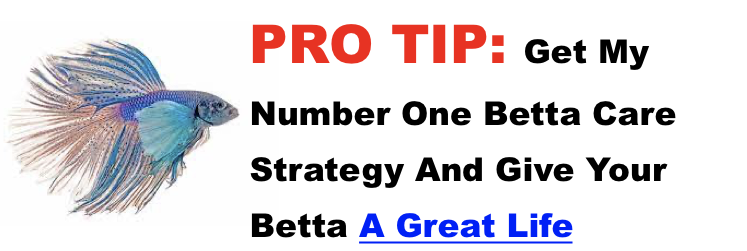
Betta Fish Fin Rot: Fin Loss, Symptoms, Causes & Treatment


Credit: aquariumopinions.com
Have your betta’s fins started to look ragged, frayed, or discolored? Don’t panic—fin rot is a common issue and one that’s completely treatable with the right steps. In this guide, you’ll learn how to identify fin rot, what causes it, the best treatment options for each severity level, and how to prevent it from coming back.
What Is Fin Rot?
Fin rot is a bacterial infection (often with a secondary fungal component) that causes a betta’s fins to become ragged, discolored, and eventually deteriorate. It usually develops due to poor water quality, stress, or injury, all of which weaken your betta’s immune system.
For help distinguishing between fin rot and simple fin loss, check out our comparison guide: Betta Fin Rot vs. Fin Loss
Symptoms of Fin Rot
Early signs:
- Frayed or ragged fin edges
- Discoloration (white, black, or red on the fin tips)
- Transparent or “melted” appearance
Moderate to severe signs:
- Holes in the fins or missing sections
- Inflamed or slimy base of the fins
- Lethargy, hiding, or appetite loss
What Causes Fin Rot?
- Poor Water Quality: Ammonia and nitrite spikes and an unclean tank environment promote the bacteria and fungi that cause fin rot. Use test strips to check water levels regularly. Learn more in our full guide on Ideal Betta Water Parameters
- Stress: Aggressive tank mates, sudden temperature changes, or overcrowding can lower immunity.
- Injury: Sharp decor or strong filters can tear fins, creating an entry point for infection.
How to Treat Fin Rot in Betta Fish
🔹 Mild Fin Rot (Early Stage)
Use Aquarium Salt
- Get water test kit
- Lower water temp to ~75°F to slow bacterial growth (but not below 74°F).
- Use a 1 tsp of aquarium salt per gallon (pre-dissolve in a separate cup).
- Perform 90% water changes daily.
- Repeat for up to 10 days. Discontinue if betta shows stress or if no improvement occurs.
🔹 Moderate Fin Rot
Use API Melafix
- Contains tea tree extract to heal damaged fins.
- Dose daily for 7 days.
- Combine with aquarium salt for better results.
- Ideal for bacterial infections and open wounds.
🔹 Severe Fin Rot / Body Rot
Use Stronger Medication (Maracyn + Maracyn 2)
- Do a 90% water change.
- Mix half the recommended dose of each product.
- Dose every 3 days for 9 days.
- If no change, pause for 4–5 days before trying again.
- Get the Betta Fish Guide Book
📅 Healing Timeline: What to Expect
- Days 1–3: Rot stops spreading
- Days 4–7: Appetite returns, fins may regain color
- Days 7–14: Fins begin regrowing (often clear at first)
- 2–4 weeks: Nearly full recovery in clean, stable tank conditions
🧱 Preventing Fin Rot from Coming Back
- Test water weekly and maintain ammonia/nitrites at 0 ppm
- Keep your tank between 78–81°F
- Use a filter with a gentle flow
- Smooth or replace sharp decorations
- Perform 25–50% weekly water changes
- Consider Indian almond leaves for natural antibacterial support
- Quarantine new fish or plants before adding to your main tank
- Ensure your setup meets proper standards. Read our full Betta Fish Tank Guide for tips on ideal tank size, equipment, and setup.
❓ Frequently Asked Questions
Is fin rot contagious?
Not directly, but poor water quality can affect all fish in the tank, making them more susceptible to infections like fin rot.
Will my betta’s fins grow back?
Yes, with proper care and clean water, your betta’s fins typically regrow within a few weeks. New fin growth often appears clear or slightly translucent.






